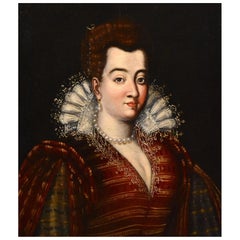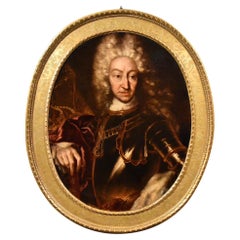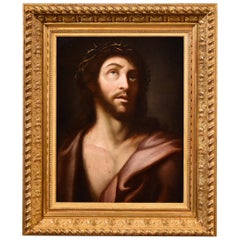Video Loading
Want more images or videos?
Request additional images or videos from the seller
1 of 18
Gentleman Portrait Knight Rigaud 18th Century Paint Oil on canvas Old master1723
1723
Price:$6,028.17
$9,826.91List Price
About the Item
- Creation Year:1723
- Dimensions:Height: 37.01 in (94 cm)Width: 31.5 in (80 cm)
- Medium:
- Movement & Style:
- Circle Of:Hyacinthe Rigaud (Perpignan 1659 - Paris 1743) Circle
- Period:
- Condition:
- Gallery Location:Riva del Garda, IT
- Reference Number:1stDibs: LU988116181752
About the Seller
4.9
Platinum Seller
Premium sellers with a 4.7+ rating and 24-hour response times
Established in 2017
1stDibs seller since 2018
260 sales on 1stDibs
Typical response time: 1 hour
Authenticity Guarantee
In the unlikely event there’s an issue with an item’s authenticity, contact us within 1 year for a full refund. DetailsMoney-Back Guarantee
If your item is not as described, is damaged in transit, or does not arrive, contact us within 7 days for a full refund. Details24-Hour Cancellation
You have a 24-hour grace period in which to reconsider your purchase, with no questions asked.Vetted Professional Sellers
Our world-class sellers must adhere to strict standards for service and quality, maintaining the integrity of our listings.Price-Match Guarantee
If you find that a seller listed the same item for a lower price elsewhere, we’ll match it.Trusted Global Delivery
Our best-in-class carrier network provides specialized shipping options worldwide, including custom delivery.You May Also Like
Painting 19th Century Romantic Courtiers Genre Scene
Located in Saint-Ouen, FR
Courtiers Party in the Park in 18th Century
In the Taste of Nicolas Lancret (1690-1743)
Oil on canvas
Frame gilded with leaves
Dim canvas : 73 X 59 cm
Dim frame : 100 X 87 cm
Category
1850s Old Masters Portrait Paintings
Materials
Oil
$8,139
H 39.38 in W 34.26 in D 3.94 in
Painting 19th century old master rural daily life
By Henri-Joseph Castaing
Located in Saint-Ouen, FR
CASTAING Henri Joseph (1860-1918)
Young girl at the source
Oil on canvas signed low left
Frame gilded with gold leaves
Dim canvas : 100 X 66 cm
Dim frame : 121 X 86 cm
CASTAING Henr...
Category
1890s Old Masters Portrait Paintings
Materials
Oil
$8,133
H 47.64 in W 33.86 in D 2.76 in
Michael Dahl (circle) 17th century portrait of Sir William Cowper
By (Circle of) Michael Dahl
Located in York, GB
Portrait of Sir William Cowper [1639-1706] Circle of Michael Dahl. (unsigned)Oil painting on canvas
17th century oval, bust-length, with a long dark wig,...
Category
17th Century Old Masters Portrait Paintings
Materials
Oil
$5,170 Sale Price
35% Off
Free Shipping
H 38 in Dm 33.08 in
Portrait of a Lady with Pink Bow - British c 1820 Old Master art oil painting
By Sir Thomas Lawrence
Located in Hagley, England
This lovely British Old Master portrait oil painting is attributed to circle of Sir Thomas Lawrence. Painted circa 1820 it is a seated half length portrait of a beautiful lady in a b...
Category
1820s Old Masters Portrait Paintings
Materials
Oil
$13,165 Sale Price
20% Off
H 40 in W 35 in D 2 in
Portrait of Lady in Mob Cap - British Old Master 18th century art oil painting
Located in Hagley, England
This charming British Old Master Regency pastel portrait is attributed to John Russell RA. Painted circa 1790 the composition is a blonde woman in pretty mob cap with a blue ribbon. A really lovely image.
Provenance. Oxford estate.
Condition. Oil pastel on paper, 23 inches by 19 inches unframed and in good condition but has line in paper in middle.
Frame. Housed in a fine frame, 30 inches by 26 inches framed and in good condition.
John Russell RA (1745-1806) was an English painter renowned for his portrait work in oils and pastels, and as a writer and teacher of painting techniques. Russell was born in Guildford, Surrey, the son of John Russell Snr., book and print seller and five times mayor of the town; his father was something of an artist, and drew and published two views of Guildford. Russell was educated at the Royal Grammar School, Guildford, and soon showed a strong inclination for art. He trained under Francis Cotes RA (of Cavendish Square, London), one of the pioneers of English pastel painting, and, like Cotes, was an admirer of the pastel drawings of Rosalba Carriera whose methods influenced his technique of "sweetening". At the age of 19 he converted to Methodism, which was the cause of tension with his family and with his teacher; he made no secret of his strong evangelical leanings and would attempt to preach and convert at every opportunity. Russell set up his own studio, in London, in 1767. He made the acquaintance of the notorious Dr. William Dodd, whose portrait he painted in 1768. He was introduced to Selina, Countess of Huntingdon, who unsuccessfully attempted to persuade him to give up painting and attend her Methodist ministers' training college at Trevecca in Wales. On 5 February 1770, he married Hannah Faden, daughter of a Charing Cross print and map seller...
Category
18th Century Old Masters Portrait Paintings
Materials
Oil
$3,263 Sale Price
20% Off
H 30 in W 26 in D 2 in
Portrait of Boy Playing a Flute - 18th/19th century art Old Master oil painting
Located in Hagley, England
This interesting painting is a British Old Master late 18th century or early 19th century oil painting attributed to Thomas Barker of Bath. It is stylistically very similar to his ot...
Category
Early 1800s Old Masters Portrait Paintings
Materials
Oil
$4,399 Sale Price
20% Off
H 35 in W 30 in D 2 in
Portrait of a Lady with Rose - British art Old Master portrait oil painting
Located in Hagley, England
This charming British early 19th century portrait oil painting is attributed to circle of Sir William Etty and is masterfully portrayed with beautiful pre Impressionist impasto. Pain...
Category
19th Century Old Masters Portrait Paintings
Materials
Oil
$6,048 Sale Price
20% Off
H 38 in W 33 in D 2 in
Joseph interpreting Dreams - Italian Old Master 17thC religious art oil painting
Located in Hagley, England
This lovely 17th century Old Master religious oil painting is from the Italian School. The subject is Joseph in prison interpreting the dreams of Pharoah's Baker and Butler. The bars...
Category
17th Century Old Masters Portrait Paintings
Materials
Oil
$7,698 Sale Price
20% Off
H 36 in W 47 in D 2 in
The Infant St John the Baptist with Lamb - Italian Old Master art oil painting
Located in Hagley, England
This beautiful 18th century Italian Old Master oil painting is something rather special. Painted circa 1750 the subject matter is Saint John the Baptist as a very young child. He is ...
Category
1750s Old Masters Portrait Paintings
Materials
Oil
$9,898 Sale Price
20% Off
H 29 in W 24 in D 2 in
Madonna and Child- Italian Old Master religious art portrait oil painting
Located in Hagley, England
This superb Italian Old Master religious portrait oil painting is attributed to circle of Bartolomeo Schedoni. Painted circa 1700 it is a half l...
Category
Early 1700s Old Masters Portrait Paintings
Materials
Oil
$6,363 Sale Price
20% Off
H 36 in W 27 in D 2 in
More From This Seller
View AllPortrait Lady Pulzone Paint Oil on canvas Old master 16th Century Italian Roma
Located in Riva del Garda, IT
Scipione Pulzone, called Il Gaetano (Gaeta 1544 - Rome 1598) - workshop of
Portrait of Bianca Cappello (Venice, 1548 - 1587) Grand Duchess of Tuscany, second wife of Francesco I de 'Medici
Second half of the 16th century
oil on canvas, cm. 70 x 56 cm., Framed 103 x 87 cm.
The proposed painting illustrates the portrait of Bianca Cappello (Venice, 1548 - 1587), a noblewoman of Venetian origins, second wife of the Grand Duke of Tuscany Francesco I de 'Medici, whose expressive power is wisely highlighted by the composite cut of light three quarters, with the head and gaze directed at the observer. The beam of light coming from her right brings out the volumes of her face plastically and lingers on her features, highlighted by the large white lace ruff that surrounds his neck and by the details of her precious clothing.
Bianca wears a dark red dress, perhaps a zimarra, embroidered in gold with a plunging neckline and a raised collar of the shirt curled in a ruff and also edged with precious lace, embroidered with the motif of the Florentine lily.
The favorite jewels of the noblewoman were pearls: we see them on a choker that adorns the neckline, in the earrings and again in the hairstyle, which sees the hair gathered at the nape of the neck and adorned with a string of small black pearls and embellished with a clasp.
It is a high-quality painting that can be confined to the workshop of the painter Scipione Pulzone called Gaetano, representing at best a pictorial genre, that of portraiture, in which the master excelled. This attribution would be confirmed by comparisons with the numerous portraits that Pulzone dedicated to the Medici family.
Our painting, in particular, could represent one of the versions that the workshop has replicated, at the request of the numerous art collectors who wish to have a portrait of one of the most influential personalities of the Florentine scene.
The characters drawn by Pulzone were icons of incomparable elegance: noblewomen, knights and religious lent their faces to the eye of the artist who was able to grasp every meticulous detail with his superb technique. A photographic wealth and surprising material attention that trace the pictorial prototypes of Flemish inspiration, in particular of Antonis Mor...
Category
16th Century Old Masters Paintings
Materials
Oil
$9,251 Sale Price
30% Off
King Portrait Clementi Paint Oil on canvas Old master 18th Century Italian
Located in Riva del Garda, IT
Maria Giovanna Battista Clementi known as La Clementina (Turin, 1692 - Turin, 1761), Attributable to
Portrait of Victor Amadeus II of Savoy (Turin 1666 - Moncalieri 1732) king of Sardinia, duke of Savoy, marquis of Saluzzo and duke of Monferrato, prince of Piedmont and count of Aosta, Moriana and Nizza from 1675 to 1720.
Oil on oval canvas,
79 x 62 cm., Framed 98 x 82 cm.
The portrayed in this fascinating virile portrait is King Vittorio Amedeo II of Savoy, portrayed in ceremonial armor and red cloak according to the traditional courtly iconography, represented half-length, slightly three-quarter-length, with the towering "courtly" wig, according to the dictates of fashion of the first decades of the century, of French inspiration.
In order to represent the power embodied in our austere portrayal, the sovereign is immortalized with the symbolic attributes of the power of the family, identifiable in the ancient crown of the Kingdom of Sardinia, in the scepter with the Mauritian cross and in the necklace of the Supreme Order of the Most Holy Annunziata, established in 1364 by Amedeo VI, as the highest honor of the House of Savoy...
Category
18th Century Old Masters Paintings
Materials
Oil
$11,125 Sale Price
35% Off
Ecce Homo Christ Paint Oil on canvas 17th Century Old master Leonardo Italian
Located in Riva del Garda, IT
Lombard painter of the seventeenth century
Ecce Homo
Oil painting on canvas
56 x 43 cm. , framed 75 x 63 cm.
Provenance: Florence, Pandolfini, 5.10.2021, lot 209
The proposed canv...
Category
17th Century Old Masters Paintings
Materials
Oil
$5,970 Sale Price
20% Off
Portrait Sibyl Lady Zanotti Paint Oil on canvas Old master 18th Century Italian
Located in Riva del Garda, IT
Portrait of an Eritrean Sibyl who writes the prophecy
Circle of Lorenzo Pasinelli (Bologna 1629 - 1700) - Attributable to Giampietro Cavazzoni Zanotti ...
Category
18th Century Old Masters Paintings
Materials
Oil
$5,601 Sale Price
20% Off
Madonna Child Del Sarto Paint Oil on table 16th Century Old master
Located in Riva del Garda, IT
Madonna and Child Workshop of Andrea del Sarto, pseudonym of Andrea d'Agnolo di Francesco (Florence 1486 - 1530)
Attributable to Jacopo di Giovanni di Francesco, known as Jacone (...
Category
16th Century Old Masters Paintings
Materials
Oil
$24,274 Sale Price
20% Off
Adoration Shepherds Von Achen Paint oil on canvas 17th Century Old master Art
Located in Riva del Garda, IT
Hans (or Johann) von Achen (Cologne 1552 - Prague 1615) workshop
Adoration of the Shepherds
Oil on canvas
112 x 90 cm./ Framed 125 x 102 cm.
The painting that we are happy to prese...
Category
17th Century Old Masters Paintings
Materials
Oil
$8,713 Sale Price
20% Off
Recently Viewed
View AllMore Ways To Browse
Hyacinthe Rigaud
Portrait Armor
Old Paris Painting
Oil Painting Dancer
Antique Victorian Portrait
Affordable Paintings
Cuban Art
Oil Painting Snow In Cities
18 X 20 Oil Painting
Italian Fine Art
Hunt Slonem Oil
Boats In A Harbor Painting
Sell Art
The Bather
Antique English Landscape Paintings
Spring Landscape Oil Painting
Red Tree
Alex Brown


